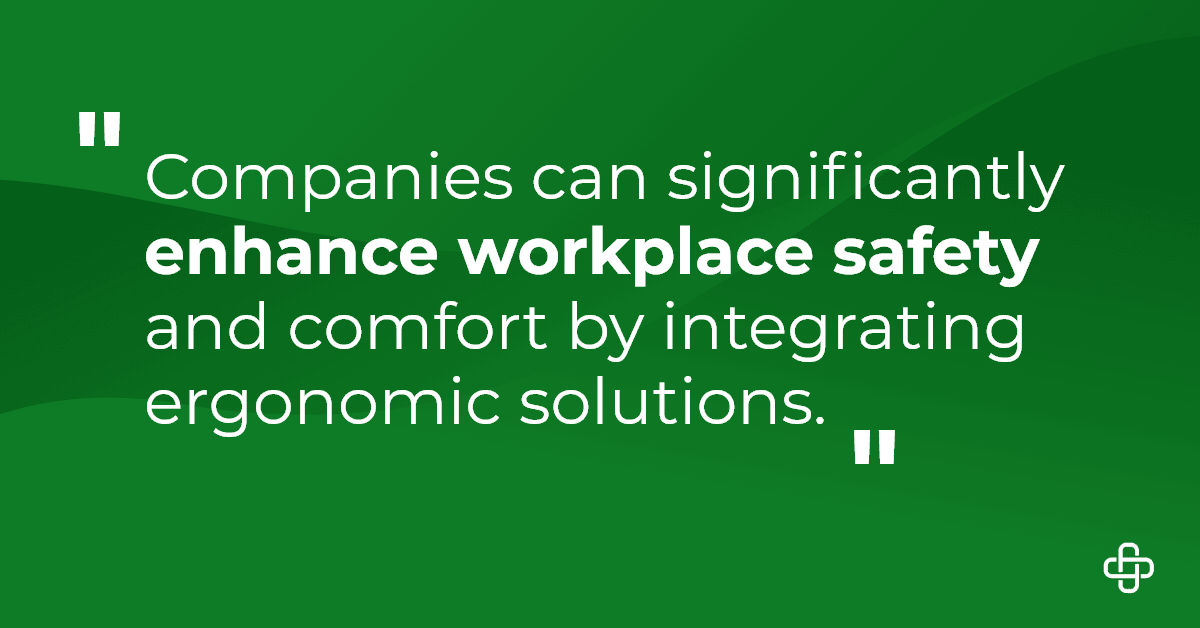Ensuring employee well-being is paramount for maintaining productivity and reducing costs related to workplace injuries.
But how do businesses create environments that support worker health? The answer lies in ergonomic innovations.
Companies can significantly enhance workplace safety and comfort by integrating ergonomic solutions.
This blog post explores how ergonomic innovations can transform your workplace and safeguard your employees from injuries.

Why Ergonomics Matter in the Workplace
When it comes to workplace safety, ergonomics often tops the list.
Ergonomics focuses on designing workspaces that fit the physical needs of employees, minimizing the risk of strain and injury.
This isn’t just about comfort—it’s about preventing repetitive strain injuries, musculoskeletal disorders, and other common workplace ailments that can lead to lost productivity, higher healthcare costs, and reduced employee morale.
Understanding ergonomics goes beyond simply knowing what it is; it involves recognizing its significance in maintaining a healthy workforce.
An ergonomic setup makes employees less likely to experience fatigue and discomfort, translating into more efficient workdays and improved overall job satisfaction.
The ripple effect of a well-designed ergonomic program can be profound, impacting not just individual workers but entire organizations.
Furthermore, implementing ergonomic solutions can directly influence a company’s bottom line. Businesses can allocate resources more effectively by reducing injury-related absences and medical expenses, ensuring sustained growth and competitiveness in their industries.
With these benefits, it’s no surprise that many organizations are investing in ergonomic innovations to stay ahead of workplace health challenges.
Understanding the Risks of Ignoring Ergonomics
Ignoring ergonomics can lead to various workplace issues that compromise employee health and operational efficiency.
One of the most significant risks is the development of musculoskeletal disorders (MSDs), which are injuries affecting muscles, nerves, tendons, and other body parts.
These disorders often result from poor posture, repetitive motions, and inadequate workstation setups—all preventable through ergonomic interventions.
Employees who suffer from MSDs may experience:
- chronic pain
- decreased mobility
- reduced ability to perform tasks
This not only affects their personal lives but also has a detrimental impact on workplace productivity.
Employers may face higher absenteeism rates, increased workers’ compensation claims, and a less engaged and motivated workforce due to ongoing discomfort.
The lack of ergonomic awareness can result in high turnover rates. Employees are more likely to seek employment elsewhere if they feel their health and well-being are not prioritized.
In today’s competitive job market, retaining skilled workers is crucial, and providing an ergonomically sound environment is a compelling factor in employee retention strategies.
Key Ergonomic Innovations Across Industries
Ergonomic innovations are being embraced across various industries to address unique workplace challenges:
- In manufacturing, for instance, ergonomically designed tools and equipment help reduce the strain on workers handling heavy machinery or repetitive tasks. Adjustable workstations and anti-fatigue mats are commonly used to improve comfort and minimize the risk of injury.
- In the oil and gas sector, ergonomic solutions focus on reducing the physical demands of fieldwork. This includes wearable technology that monitors physical exertion and suggests breaks, as well as equipment designed to minimize manual handling. These measures are vital when workers face extreme conditions and demanding tasks.
- Construction sites benefit from ergonomic innovations such as exoskeletons and lifting devices, which assist workers in handling heavy materials safely. These technologies reduce the risk of back injuries and enable workers to perform tasks more efficiently.
Best Practices for Implementing Ergonomic Changes
To successfully implement ergonomic changes, businesses must thoroughly assess their workplace conditions.
This involves evaluating tasks, equipment, and employee feedback to identify areas where ergonomic improvements are needed. Once these areas are pinpointed, companies can prioritize changes that will significantly impact worker safety and comfort.
Employee involvement is crucial in the implementation process. Engaging workers in discussions about ergonomic improvements fosters a sense of ownership and commitment to the changes.
Providing training sessions and resources that educate employees on proper ergonomic practices further supports a smooth transition and helps embed these practices into daily routines.
Continuous evaluation and adaptation of ergonomic strategies ensure sustained success. Regularly reviewing the effectiveness of implemented changes and gathering employee feedback allows for adjustments and enhancements as needed.
The Future of Workplace Ergonomics
The future of workplace ergonomics holds exciting possibilities as technology continues to advance.
Collaboration between industries and ergonomic experts is expected to drive further advancements.
By sharing best practices and research findings, companies can collectively enhance their ergonomic programs and address common challenges.
This collaborative approach ensures that ergonomic innovations continue evolving and adapting to diverse industries’ changing needs.
Axiom Medical: Leading the Way in Employee Health Solutions
Axiom Medical stands at the forefront of worker health solutions, offering approaches to enhancing employee well-being across industries.
Their comprehensive suite includes fatigue assessments, proactively addressing one of the most pressing issues in today’s workforce—workplace fatigue.
By implementing their solutions, Axiom Medical enables organizations to identify and manage factors contributing to worker fatigue, ultimately improving safety and productivity.
Moreover, their injury case management solution delivers personalized care, guiding injured workers through recovery with meticulous attention to their needs.
This proactive support expedites recovery and minimizes costs associated with workplace injuries, demonstrating Axiom Medical’s dedication to creating healthier, more resilient workforce communities.
Final Thoughts
Incorporating ergonomic innovations into the workplace is not just a choice—it’s necessary for businesses aiming to protect their employees and optimize productivity.
By adopting ergonomic solutions, companies can reduce the risk of injuries, enhance job satisfaction, and improve overall operational efficiency. Proactive ergonomic practices create environments where employees thrive, contributing to long-term success and competitiveness.
For professionals seeking to deepen their understanding of workplace safety and ergonomic strategies, Axiom Medical’s upcoming webinar, “Data Driven Insights for Safety,” offers a valuable opportunity.
Participants will explore data analysis techniques that predict safety issues and learn how to implement stronger safety protocols based on insightful trends.
Whether you’re catching the live session or watching the replay, this webinar provides actionable insights to rapidly upgrade your safety protocols.










